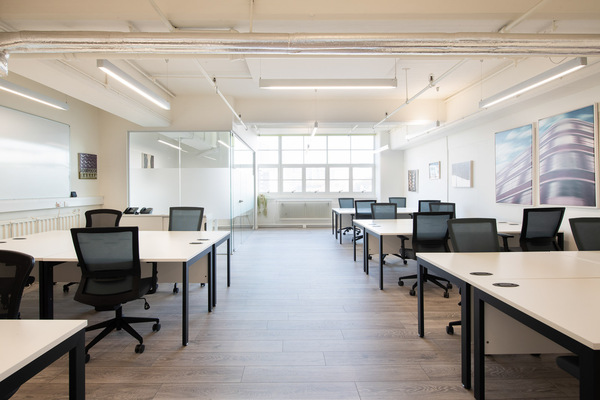
When it comes to renting an office space, there are two main types of agreements that you can use: leases and licences. Both have their own benefits and drawbacks, so it's important to choose the right one for your needs.

What is a Licence agreement?
The main advantage of a licence agreement is that it is quick and easy to set up and commit to. Licence agreements are also usually more flexible than other types of agreements, such as leases, which can make them ideal for businesses that are not sure how long they need the space for.

What is included in a licence agreement?
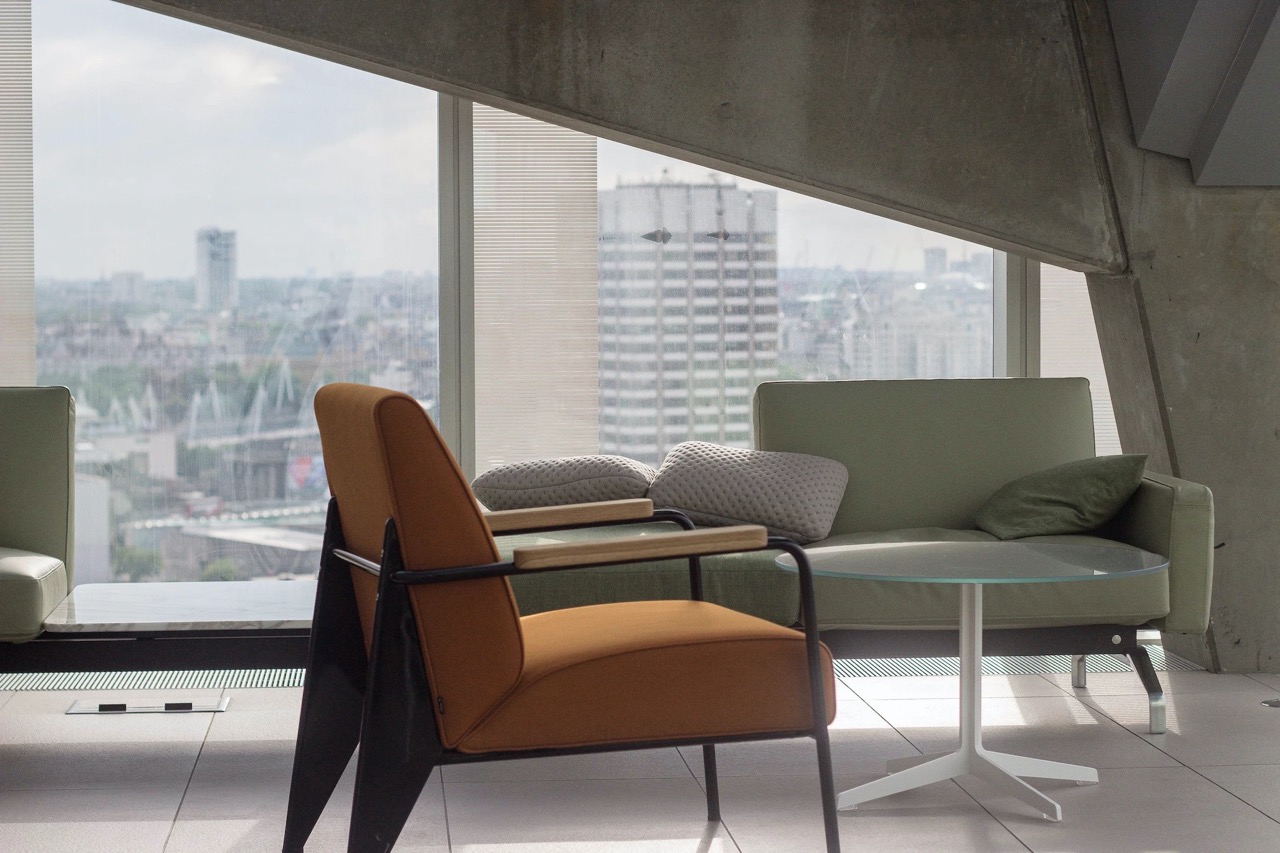
- Good for companies who want a fully serviced workspace with a single monthly fee, Licence agreements typically cover all-inclusive workspaces so you don't have to worry about bills and rates.
- If you are not ready to commit to a long-term lease. Licence agreements are normally for periods of less than two years. instead of the 5–10 years that you would expect if you were to take on an office lease.
- Licence agreements typically involve less paperwork and less stringent terms than traditional leases, making them a relatively straightforward process and good for businesses who want to move into an office space quickly.
- Licence agreements can be easily renewed or terminated if necessary, making this a good choice for businesses looking for flexibility.
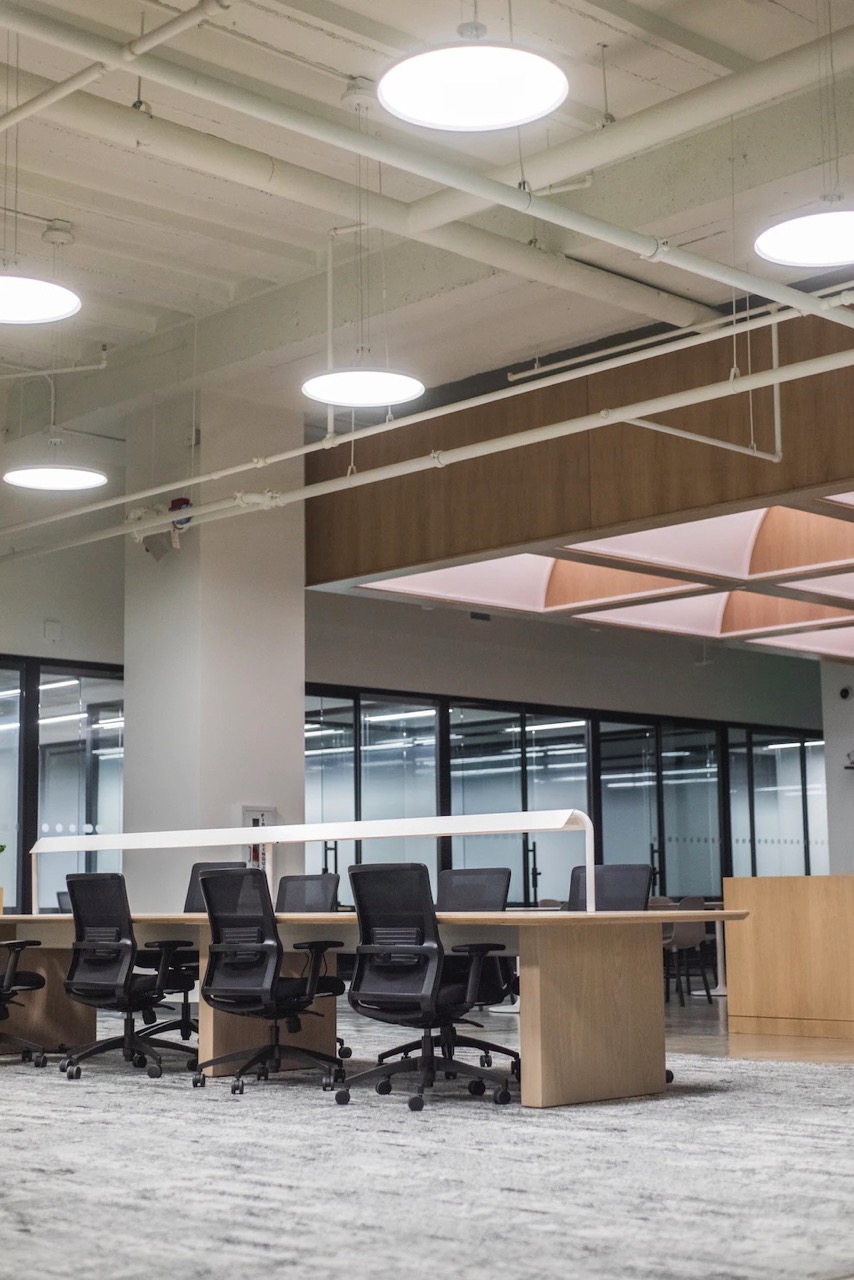
- The terms on what you can do to the space are normally more limited than leases which means you can't make drastic changes to the space for branding or refurbishments.
- Licence agreements do not provide the same security of tenure as lease agreements. Whilst this rarely causes issues, it is worth being aware that were the licensor to dispose of their interest in the property, your right of occupancy would immediately cease.
- Licences are individual and linked to one company - they cannot be transferred.
What is an office lease?
A legally binding contract where a company agrees to pay a landlord a rental amount to occupy and use space on an exclusive basis for a fixed term. A lease details the rights, obligations, responsibilities, and financial implications for both parties. Unlike a licence agreement, the tenant will have the right to exclusive possession.

What is included in a commercial office lease?
The lease will specify the length of the lease, square footage, rent amount, and associated fees. The agreement will also say things like the hours of operation, what can and can't be done with the space, and what can and can't be done with subletting or assigning the lease. A commercial office lease typically requires a minimum term (usually at least 6 months).

- Having exclusive occupation means that tenants can make changes to their space as they desire and make it feel fully on- brand without having to worry about accommodating another business.
- With a longer lease term, overall costs may be reduced due to less frequent renewals or relocation costs.
- A commercial office lease can also offer flexibility when it comes to subletting or assigning unused space if tenants choose not to utilise it. This is beneficial particularly for businesses that may require extra space during peak periods or need more room when expanding operations. However, if this is one of the reasons you are opting for a lease it is important that you get legal advice to ensure this is possible under the specific terms of your lease.
- Leases provide greater security. When signing a lease you create a legal interest in the property so any sale of the property during the agreed term must be subject to the tenant’s lease.
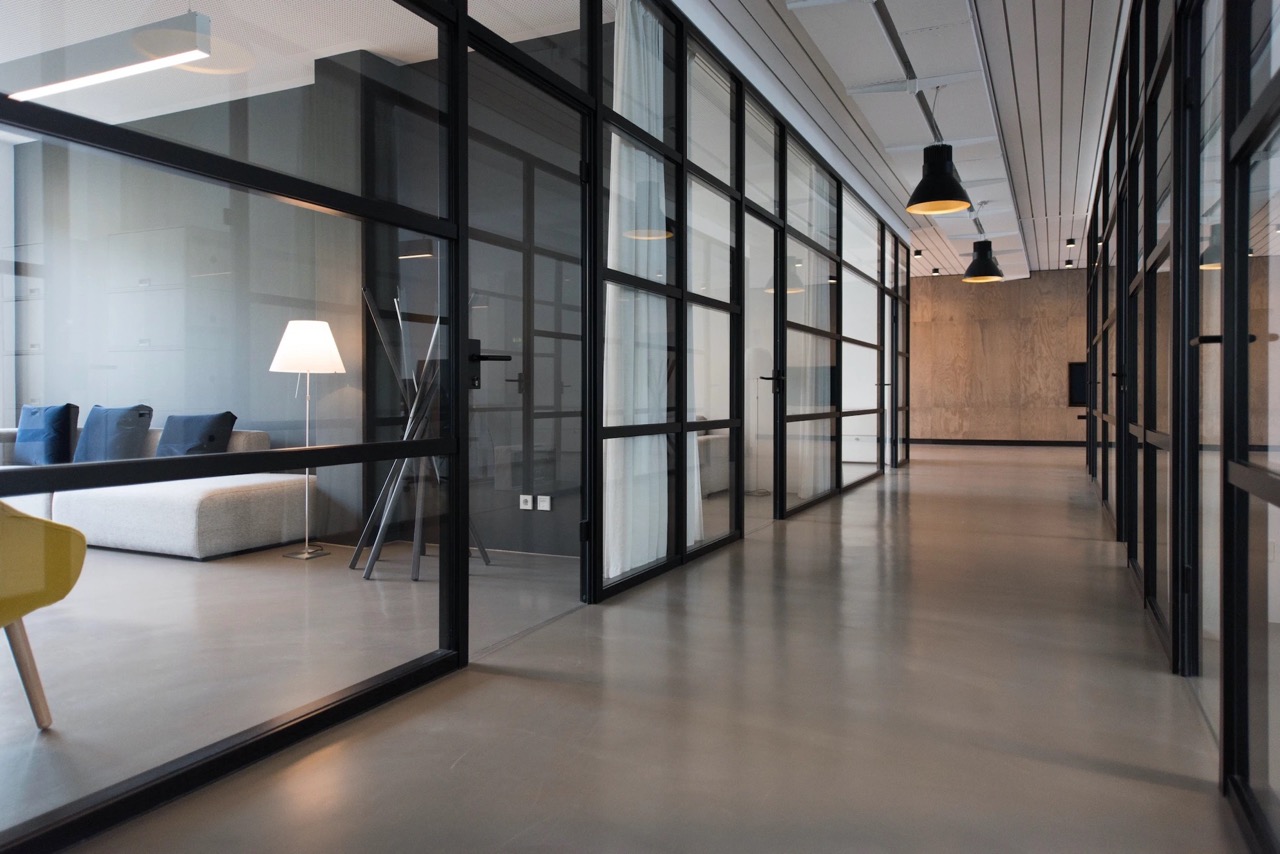
What are the negatives of commercial office leases?
- Perhaps the most significant disadvantage is the upfront costs associated with a commercial lease including agent's fees, legal fees and fit-out costs. Agent's fees are typically charged by a real estate agent to facilitate the transaction between landlord and tenant. Fit-out costs for renovations or modifications that need to be made in order for the tenant to use the property can be high. These may range from repainting walls to adding fixtures or furniture.
- Another issue is complex legal processes. There is often a negotiation process over terms such as length of lease and renewal options which can take weeks or even months before an agreement is reached.
- Move-in time is significantly higher than for licence agreements. It typically takes 3-12 months from the signing of the contract before it is possible for the tenant to move into their new premises; this period includes the time needed for fit-outs and other administrative work.
- Less flexibility can also cause issues e.g. if undesirable neighbours move into a nearby property, with no recourse, tenants may find themselves stuck in a property they no longer want.
- In some cases leases may include clauses regarding rent increases should certain conditions arise (such as if additional commercial properties become available in close proximity). If those conditions arise then landlords have both legal privilege and financial incentives to raise rents significantly above market rate; such jumps in rent can quickly put businesses under financial pressure if their cash flows cannot accommodate them.
- Dilapidations costs when the lease ends. Dilapidations refer to charges levied by the landlord at the end of the lease period if damage has been done to the property; these are often not negotiable and must be paid in full prior to vacating.

Ultimately, the decision of whether to sign a licence agreement or a lease depends on the specific needs of the business. Licence agreements are typically shorter than leases, and they offer more flexibility in terms of use and length of stay. However, licence agreements also tend to be more expensive in the short term, and they often don't include any provisions for renewing or extending the agreement. Office leases, on the other hand, are usually longer-term agreements that can provide some stability and predictability in terms of cost. But leases can be inflexible, and they may require a business to make significant renovations or changes to the space. To help you decide what is best for your business we’ve included a table summarising the key features of both.
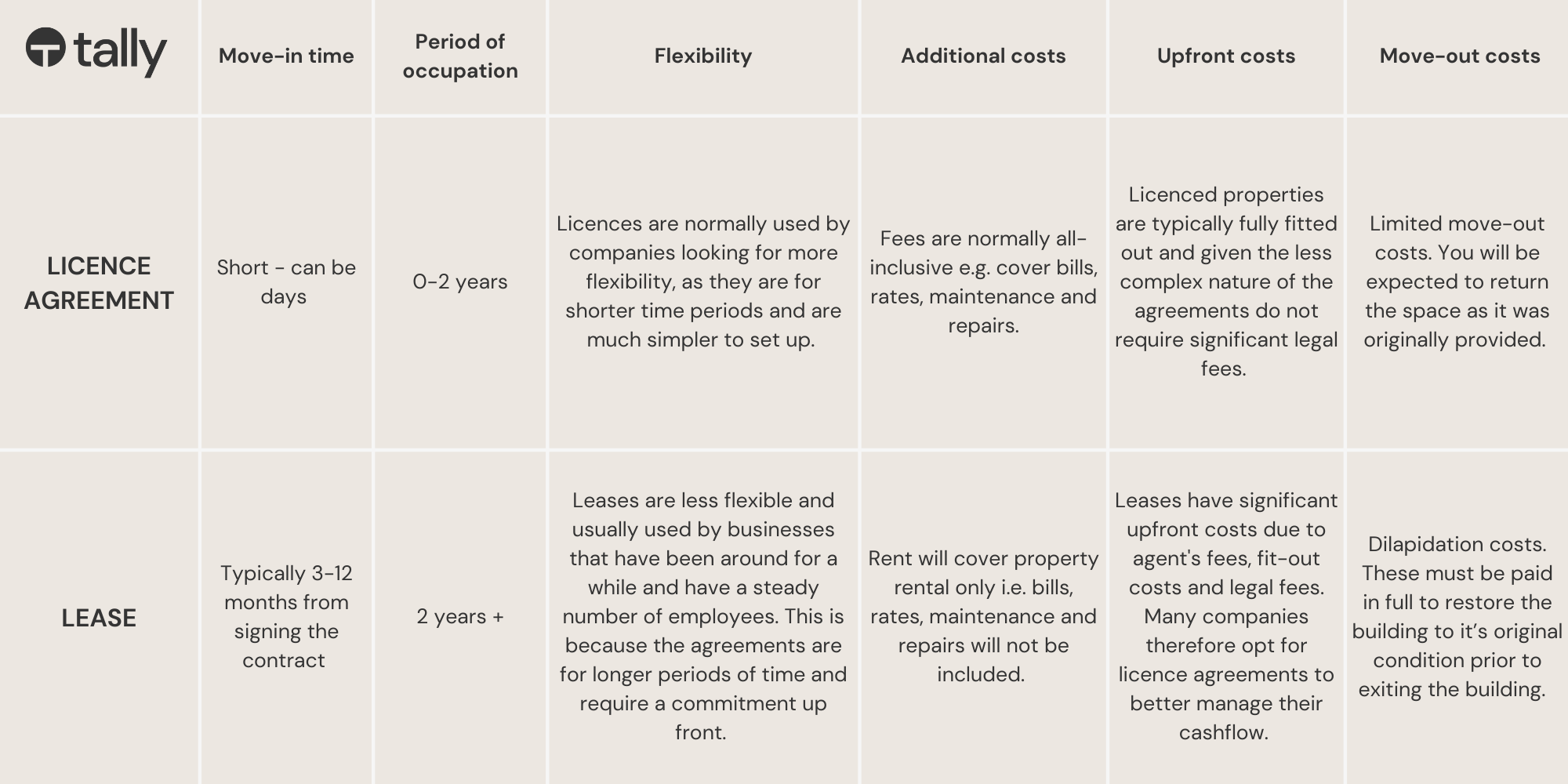
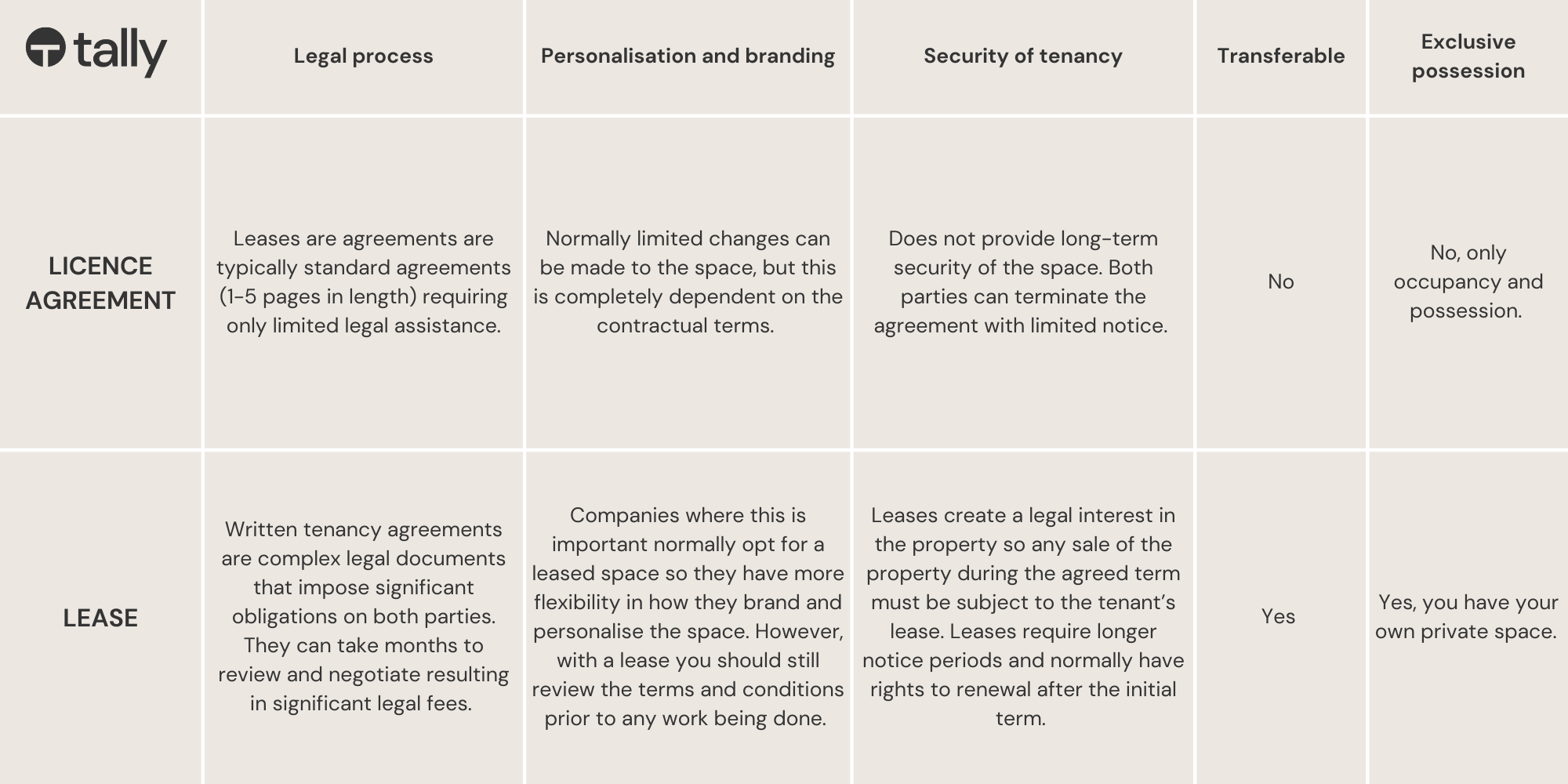
- Rental rates
- VAT
- Business rates
- Utility/energy bills
- Water rates
- Phone line
- Deposit
- Insurance (buildings and contents)
- Fit-out costs
- Furniture and equipment
- Cashflow costs (especially if paying for large fit-out or deposit)
- Professional fees e.g legal fees, surveyors, agents
- Repairs and maintenance
- Wi-fi costs
- Cleaning
- Local authority charges e.g. waste disposal or parking
- Office manager or any additional staff costs to manage the space
- Dilapidations
- SDLT on leases (charged when a lease exceeds a certain value)
- Meeting room costs (some share office spaces offer free meeting rooms or meeting room credits but where this is not the case or you have high meeting room usage it can quickly pay off to have your own internal meeting room)

The key differences between a licence and a lease are that leases are:
- Exclusive possession
- Of defined premises
- For a term which is certain (either fixed term or periodic tenancy)

If you're looking for a new office space your whole team will love, let us know your requirements here. No matter how soon you want to move or what is important to you, we'll be able to match you up with the perfect new space.
Check out are other practical articles on getting an office space:
- The Complete Guide to UK Business Rates (2023)


